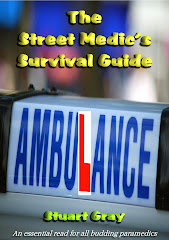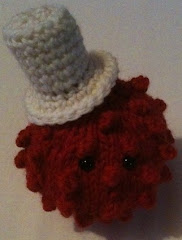Day shift: Five calls; one treated on scene; two by ambulance; two by car.
Stats: 1 Feeling faint; 1 ? Fractured Humerus; 1 Sprained ankle; 1 TIA; 1 Epistaxis.
I started the day with a ‘feeling faint’ that may or may not have had more to do with stress than the assumed cardiac connection made and given a resultant Red category. The 56 year-old man was at work in an office and has had two days of feeling like he was ‘missing a breath and a heartbeat’ every now and then. He also felt dizzy and faint and had visual disturbances at times, especially when he was sitting in front of his computer for any length of time concentrating.
He was taking beta blockers for diagnosed high blood pressure and when I checked it I found it to be up there at 180/90, so this gave the call a non-routine complexion but, before we all dive off the deep end, he looked stressed. He looked like he was the stressy type and he admitted to being so. He also knew what white coat syndrome was and so his blood pressure would probably have been behaving according to his disposition at the time. I will doubtless hear the ‘but his beta blockers would surely have been controlling that’ argument but I’ve seen this a lot and stress is a major factor for such changes in non-critical circumstances. His visual problems and that feeling of missing a breath could be down to anxiety. Nevertheless, he needed an ECG (incidentally, he had no chest pain) and a more thorough check up before a conclusion based on his lifestyle could be determined. If I was able to describe this man and then the environment in which he worked, you’d understand my reluctance to worry too much about him.
Then an 84 year-old lady stumbled over a quite frankly stupid and impractical device, comprising a length of rope and a few metal posts at ankle height, designed to prevent people from getting to close to works of art (paintings) at a gallery. She fell onto her knees and then slammed into the wall below the painting, damaging and probably fracturing, her mid-shaft humerus. This is a painful and significant injury at any age, never mind mid-80’s.
Luckily she was the strong type and, apart from the arm injury, had sustained no other damage on her trip. There was no first aid room or anywhere suitable to take her for obs and conversation about her personal medical history (this is, as you know, a real bug for me) and so, with the help of security and her friends, we wheeled her to the best place we could find for this – a conference room in which a small meeting was taking place. People were cleared and apologised to but I think this elderly lady will be writing harsh words about the stupidity of that small barrier (what’s it for, nosey dogs?) and the lack of proper facilities in a crowded place.
Sprained ankles are not generally life threatening, so if you are 28 years-old and can hop, either get a taxi or a friend to take you to the nearest A&E or Minor Injuries Unit where you will wait for possibly hours as they wheel in one true emergency after another. This man, who was on his way to work when he slipped on steps and twisted his ankle, continued on until he could no longer put weight on it before allowing his colleagues to dial 999 and declare it an emergency. There was no first aider to be seen, even though in a company that large there should have been and he had been given no treatment for it. His shoe and sock were still on his affected foot. A smart first aider would have assessed it, seen it for what it was (a sprain), given it the old RICE treatment and then had him taken to hospital for an x-ray, if required (and under the Ottowa rules it probably was) and that would have been the end of it. That being done, someone dying in the street elsewhere would get a timely ambulance response in the hope that the dying thing could be reversed.
At one of the nicest hotels in London a 65 year-old American woman had a small stroke – a TIA – whilst having her hair done. One of the other FRU’s on duty was called first and I got there a few seconds behind in support because the initial call sounded like it was going to become a suspended (cardiac arrest).
The woman had been put in the recovery position by a member of staff and she was completely unaware and unable to communicate. One side was weak and she was mildly combative when things were done to her, such as the BM check but oxygen helped her to recover and she went from incapable to survivor in ten minutes. She was able to speak a little when we started to move her down to the ambulance, where her frail and elderly husband waited in the street, hotel staff members all around him.
The lady’s ECG showed PVC’s after every normal beat, running in pairs – known as bigeminal couplets; something we don’t get to see much of, so it was interesting to analyse. She was taken, with her husband, to hospital on blue lights and the hotel manager promised a car would pick one or both of them up and return them to their room, depending on the outcome, which is hopefully favourable.
In a cruel twist they sent me to women-only spa where a 45 year-old lady was having a nosebleed that had gone on for 30 minutes. So, I was chaperoned all the way through to the changing rooms and had to stand in a small toilet with the lady and her friend as I covered her poorly nose until it stopped bleeding and we could all put it behind us. Actually, she was the sensible type and had experienced these epistaxal experiences before; they always occurred after having a cold and then going into warm places (like a spa for example). This was her longest bleed though, so her friend got panicky and made the patient feel embarrassed when I walked in to help her with something she’d been able to deal with all her adult life. I made things better for her by assuring her that she didn’t have to go to A&E if she didn’t want to, (which she didn’t) and that HEMS were being stood down.
Then I went home.
Be safe.
Subscribe to:
Post Comments (Atom)















No comments:
Post a Comment